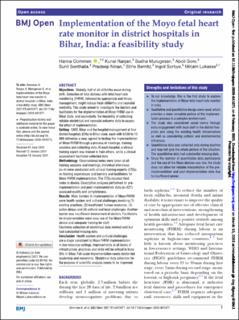| dc.contributor.author | Oommen, Hanna | |
| dc.contributor.author | Ranjan, Kunal | |
| dc.contributor.author | Murugesan, Sudha | |
| dc.contributor.author | Gore, Aboli | |
| dc.contributor.author | Sonthalia, Sunil | |
| dc.contributor.author | Ninan, Pradeep | |
| dc.contributor.author | Bernitz, Stine | |
| dc.contributor.author | Sørbye, Ingvil | |
| dc.contributor.author | Lukasse, Mirjam | |
| dc.date.accessioned | 2022-10-10T11:20:02Z | |
| dc.date.available | 2022-10-10T11:20:02Z | |
| dc.date.created | 2021-02-26T09:54:23Z | |
| dc.date.issued | 2021-02-08 | |
| dc.identifier.citation | BMJ Open. 2021, 11 (2), 1-10. | en_US |
| dc.identifier.issn | 2044-6055 | |
| dc.identifier.uri | https://hdl.handle.net/11250/3025083 | |
| dc.description.abstract | Objectives: Globally, half of all stillbirths occur during birth. Detection of fetal distress with fetal heart rate monitoring (FHRM), followed by appropriate and timely management, might reduce fresh stillbirths and neonatal morbidity. This study aimed to investigate the barriers and facilitators for the implementation of Moyo FHRM use in Bihar state, and secondarily, the feasibility of collecting reliable obstetrical and neonatal outcome data to assess the effect of implementation. Setting: CARE Bihar and the hospital management at four district hospitals (DHs) in Bihar state, each with 6500 to 15 000 deliveries a year, agreed to testing the implementation of Moyo FHRM through a process of meetings, training sessions and collecting data. At each hospital, a clinical training expert was trained to train others, while a clinical assessment facilitator collected data. Methodology: Observational notes were taken at all training sessions and meetings. Individual interviews (n=4) were conducted with clinical training experts (CTEs) on training experiences and barriers and facilitators for Moyo FHRM implementation. The CTEs recoded field notes in diaries. Descriptive analyses performed on pre-implementation and post-implementation data (n=521) assessed quality and completeness. Results: Main barriers to implementation of Moyo FHRM were health system and cultural challenges involving (1) existing practices, (2) insufficient human resources, (3) action delays and (4) cultural and local challenges. Another barrier was insufficient involvement of doctors. Facilitators for implementation were easy use of the Moyo FHRM device and adequate training for staff. Electronic collection of obstetrical data worked well but had substantial missing data. Conclusion: Health system and cultural challenges are a major constraint to Moyo FHRM implementation in low-resource settings. Improvements at all levels of infrastructure, practices and skills will be critical in busy DHs in Bihar. Full-scale implementation needs doctor-led leadership and ownership. Obstetrical data collection for the purpose of scientific analysis needs to be improved. | en_US |
| dc.description.sponsorship | The feasibility study was supported by the Laerdal Foundation. | en_US |
| dc.language.iso | eng | en_US |
| dc.publisher | BMJ Publishing Group | en_US |
| dc.relation.ispartofseries | BMJ Open;Volume 11, Issue 2 | |
| dc.rights | Navngivelse-Ikkekommersiell 4.0 Internasjonal | * |
| dc.rights.uri | http://creativecommons.org/licenses/by-nc/4.0/deed.no | * |
| dc.subject | Fosterovervåking | en_US |
| dc.subject | Fetal surveillance | en_US |
| dc.subject | Global Helse | en_US |
| dc.subject | Global Health | en_US |
| dc.subject | Internasjonal kvinnehelse | en_US |
| dc.subject | International Women`s Health | en_US |
| dc.subject | Stillbirths | en_US |
| dc.subject | Heart rate monitoring | en_US |
| dc.subject | Reproductive health | en_US |
| dc.title | Implementation of the Moyo fetal heart rate monitor in district hospitals in Bihar, India: a feasibility study | en_US |
| dc.type | Peer reviewed | en_US |
| dc.type | Journal article | en_US |
| dc.description.version | publishedVersion | en_US |
| dc.rights.holder | © Author(s) (or their employer(s)) 2021 | en_US |
| dc.source.articlenumber | e041071 | en_US |
| cristin.ispublished | true | |
| cristin.fulltext | original | |
| cristin.qualitycode | 1 | |
| dc.identifier.doi | https://doi.org/10.1136/bmjopen-2020-041071 | |
| dc.identifier.cristin | 1893934 | |
| dc.source.journal | BMJ Open | en_US |
| dc.source.volume | 11 | en_US |
| dc.source.issue | 2 | en_US |
| dc.source.pagenumber | 1-14 | en_US |
| dc.subject.nsi | VDP::Helsefag: 800 | en_US |
| dc.subject.nsi | VDP::Health sciences: 800 | en_US |

